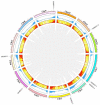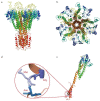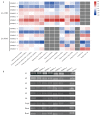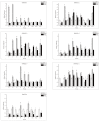Identification and Expression of the CorA/MRS2/ALR Type Magnesium Transporters in Tomato
- PMID: 37447072
- PMCID: PMC10347230
- DOI: 10.3390/plants12132512
Identification and Expression of the CorA/MRS2/ALR Type Magnesium Transporters in Tomato
Abstract
Magnesium (Mg2+) is the most abundant divalent ion in plants, participating in numerous metabolic processes in growth and development. CorA/MRS2/ALR type Mg2+ transporters are essential for maintaining Mg2+ homeostasis in plants. However, the candidate protein and its potential functions in the tomato plant have not been fully understood. In this study, we identified seven MGT genes (SlMRS2) in tomato based on sequence similarity, domain analysis, conserved motif identification, and structure prediction. Two SlMRS2 genes were analyzed in the bacterial strain MM281, and a functional complementary assay demonstrated their high-affinity transport of Mg2+. Quantitative real-time PCR analysis revealed that the expressions of these Mg2+ transporters were down-regulated in leaves under Mg2+ limitation, with a greater impact on lower and middle leaves compared to young leaves. Conversely, under Mg2+ toxicity, several genes were up-regulated in leaves with a circadian rhythm. Our findings indicate that members of the SlMRS2 family function as Mg2+ transporters and lay the groundwork for further analysis of their distinct functions in tomato.
Keywords: RT-PCR; genomic analysis; magnesium transporter; qRT-PCR; tomato (Solanum lycopersicum L.).
Conflict of interest statement
The authors declare no conflict of interest.
Figures











Similar articles
-
Identification, and Functional and Expression Analyses of the CorA/MRS2/MGT-Type Magnesium Transporter Family in Maize.Plant Cell Physiol. 2016 Jun;57(6):1153-68. doi: 10.1093/pcp/pcw064. Epub 2016 Apr 15. Plant Cell Physiol. 2016. PMID: 27084594
-
The maize CorA/MRS2/MGT-type Mg transporter, ZmMGT10, responses to magnesium deficiency and confers low magnesium tolerance in transgenic Arabidopsis.Plant Mol Biol. 2017 Oct;95(3):269-278. doi: 10.1007/s11103-017-0645-1. Epub 2017 Sep 4. Plant Mol Biol. 2017. PMID: 28871377
-
Expression and functional analysis of the CorA-MRS2-ALR-type magnesium transporter family in rice.Plant Cell Physiol. 2013 Oct;54(10):1673-83. doi: 10.1093/pcp/pct112. Epub 2013 Aug 7. Plant Cell Physiol. 2013. PMID: 23926064
-
Molecular identification of the magnesium transport gene family in Brassica napus.Plant Physiol Biochem. 2019 Mar;136:204-214. doi: 10.1016/j.plaphy.2019.01.017. Epub 2019 Jan 17. Plant Physiol Biochem. 2019. PMID: 30690277 Review.
-
Critical Issues in the Study of Magnesium Transport Systems and Magnesium Deficiency Symptoms in Plants.Int J Mol Sci. 2015 Sep 23;16(9):23076-93. doi: 10.3390/ijms160923076. Int J Mol Sci. 2015. PMID: 26404266 Free PMC article. Review.
Cited by
-
Identification of MRS2 Gene Family and Expression Analysis in Response to Magnesium Treatment in Malus domestica.Plants (Basel). 2025 May 30;14(11):1672. doi: 10.3390/plants14111672. Plants (Basel). 2025. PMID: 40508346 Free PMC article.
-
Genome-wide identification of MGT gene family in soybean (Glycine max) and their expression analyses under magnesium stress conditions.BMC Plant Biol. 2025 Jan 22;25(1):83. doi: 10.1186/s12870-024-05985-7. BMC Plant Biol. 2025. PMID: 39838318 Free PMC article.
References
-
- Marschner H. Mineral Nutrition of Higher Plants. 3rd ed. Academic Press; San Diego, CA, USA: 2012. p. 672. - DOI
-
- Tunc-Ozdemir M., Tang C., Ishka M.R., Brown E., Groves N.R., Myers C.T., Rato C., Poulsen L.R., McDowell S., Miller G., et al. A Cyclic Nucleotide-Gated Channel (CNGC16) in Pollen Is Critical for Stress Tolerance in Pollen Reproductive Development. Plant Physiol. 2013;161:1010–1020. doi: 10.1104/pp.112.206888. - DOI - PMC - PubMed
-
- Guo W.L., Nazim H., Liang Z.S., Yang D.F. Magnesium deficiency in plants: An urgent problem. Crop J. 2016;4:83–91. doi: 10.1016/j.cj.2015.11.003. - DOI
LinkOut - more resources
Full Text Sources
Miscellaneous

